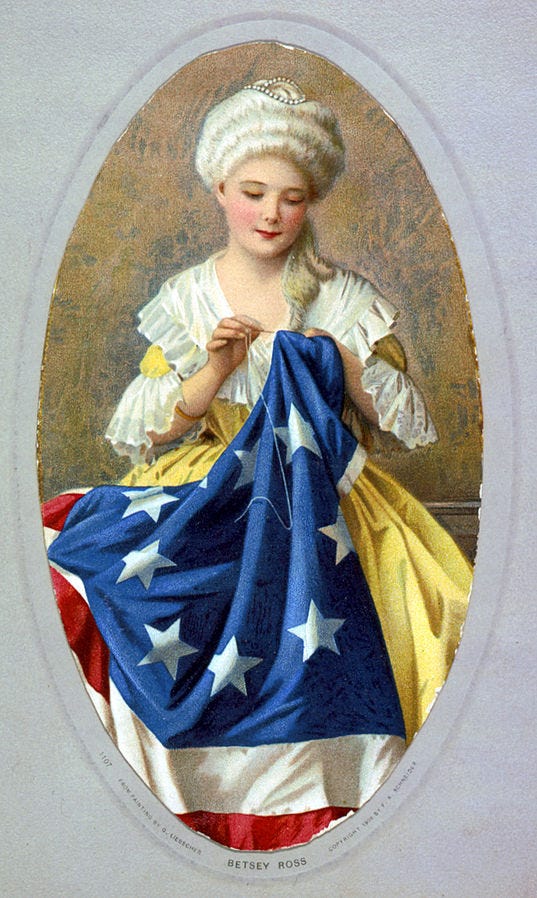It was 1776, and the American Colonies were at war with Britain for independence. They needed a symbol of identity for the battlefield. They needed a flag.
Now, the following is based on a family's lore, but as the story goes, General George Washington and a couple of other men approached a twenty-four-year-old seamstress named Betsy Ross with a sketch of a new flag. General Washington knew Betsy as she had done some work for his home. And one of the other men was the uncle of her late husband. She was also known for producing flags for groups such as Pennsylvania's navy.
Betsy reviewed their design and suggested one change: a five-pointed star instead of the original six-pointed design. Then, she demonstrated her practicality and skill by cutting a perfect five-pointed star with a single scissors snip.
As Betsy would later tell family and friends, who then passed down the story across generations, she received the commission to create America's first flag. While historians debate its authenticity, Betsy's story remains a cherished piece of American folklore.
Betsy was born Elizabeth Griscom on January 1, 1752, in Philadelphia, Pennsylvania, which at the time was the largest city in the American Colonies and a center of commerce, culture, and political thought. She was the eighth of seventeen children growing up in a strict Quaker household where hard work, humility, duty, and education were the esteemed values for life.
In the early years of Betsy's life, her father, a skilled carpenter, instilled in her a love for craftsmanship. In later youth, Betsy began apprenticing as an upholsterer, a trade that included furniture upholstery, sewing curtains, bedcovers, and flags. Her talent and diligence soon set her apart.
Then came a tumultuous period in her personal life. In 1773, she married John Ross, crossing the religious divide between her Quaker upbringing and his Anglican faith. The controversial marriage led to her expulsion from the Quaker community.
But together, the couple leveraged her talent by opening an upholstery shop in Philadelphia. However, tragedy struck early in 1776 when John died in a munitions explosion while serving with a local militia.
At just 24 years old, Betsy became a widow with a business to run and a war on her doorstep. After her husband's death, she also had to deal with the British occupation of Philadelphia, which was making life difficult. British troops took over homes, turning them into barracks and commandeering supplies. Food and goods became scarce, and the economy suffered as businesses were disrupted. There were also strict curfews and Patriot sympathizers risked imprisonment or worse if caught aiding the revolutionary cause. Tension and unease marked the atmosphere. Yet, she continued to produce military supplies, offering crucial support to the Revolutionary cause.
After the war, Betsy remarried twice. Her second husband, Joseph Ashburn, a sailor, was captured by the British and died in prison. John Claypoole, her third husband, was the very man who delivered the heartbreaking news of Joseph’s death.
Betsy and John would have a long marriage, raising five daughters together until he died in 1817. She continued working as an upholsterer well into her later years, remaining active in her trade and community.
On January 30, 1836, she passed away at the age of 84.
Sources:
Alexander, Kerri Lee. "Betsy Ross." National Women's History Museum. 2019. www.womenshistory.org/education-resources/biographies/betsy-ross.
“American Revolution Facts.” American Battlefield Trust, https://www.battlefields.org/learn/articles/american-revolution-faqs
Betsey sic Ross. Photograph. Retrieved from the Library of Congress, <www.loc.gov/item/94507644/>.
Duden, Jane. Betsy Ross. United States, Capstone, 2000.
Ferris, Jean Leon Gerome, Artist. Betsy Ross,/ J.L.G. Ferris. Cleveland, Ohio: The Foundation Press, Inc., July 28. Photograph. Retrieved from the Library of Congress, <www.loc.gov/item/2002719536/>.
Wikimedia Commons, Wikimedia Foundation, https://commons.wikimedia.org/wiki/File:Betsy_Ross_1777_cph.3g09905.jpg
Wikimedia Commons, Wikimedia Foundation, https://en.m.wikipedia.org/wiki/File:Betsy_Ross_sewing.jpg






With our country and life once again in upheaval, such stories help to sustain and strengthen me. Along with Betsy, we must maintain a quiet, unwavering belief in our beloved country. At times out of this quiet rebellion, we will be called to shout our beliefs from the rooftops and perhaps do dangerous things. This curious combination of stealthy resistance which then enables acts of overt rebellion was also demonstrated by the French resistance during WWII. These are freighting times but reading stories of strength from our history will help to sustain us.